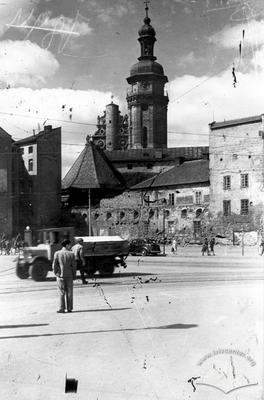
Mytna Square
- ID: 626
- Place: Lviv
- Date: 1937
A copy of this photo, one of a much worse quality but in a wider perspective, was used as an illustration in a book by Fedir Ernst entitled The Contracts and the Contract House in Kyiv (Ернст, Федір. Контракти і контрактовий будинок в Київі. К: Всеукраїнська академія наук, 1924. С. 76). “Contracts! For a Kyiv resident, this word means quite a lot. The month of February. On the ground, there is snow, crisp at first and wet and dirty later. The square at Podil is filled with stalls, made of boards. A dense crowd is hurrying and scurrying to and fro. Sazhen long fishes are set out in front of shops just here, on the square. Waffles are smoking there; “little devils” and “mother’s-in-law tongues” are being sold there; heaps of Nechaiv honey cakes are piled on there. There are shops selling small wares and all sorts of various small things. One can hear annoying cries of vendors: “Twenty five envelopes for five each, twenty five!” The grey, time-worn Contract House with its four columns all plastered with advertisements. Inside one can see “eastern men” selling shawls and slippers, a Tatar selling Kazan soap, linen, Ural stones, huge heaps of many-coloured textiles, galoshes, Vyazma honey cakes (which have never been to Vyazma), turned things made by the blind and postcards in sealed envelopes – “for married persons only”, writes Ernst in the introductory paragraph.
In the center of the photo, there is the dominant of the Contract Fair – the Contract House, standing out due to its scale, height and shapes against the background of the neighbouring houses, which have one or two floors for the most part. The Contract House has a rather refined four-column portico with a triangular pediment. One can see an advertisement of “Siberian sarpinka” on the Contract House columns; sarpinka was a cloth like printed calico made by German colonists of the Volga region.
In the background, the industry of the Ploska area (now Podil and Lukyanivka) can be seen. On the columns, there are billboards telling about goods offered for sale. On the left wooden stalls can be seen, which are not too well protected from winter’s bad weather.
Olga Martyniuk